The History of Computing at TCU
Contents:
Timeline:
1960-1961
- TCU receives its first computer, an IBM 1620 to support the work of the Institute of Behavioral Research (IBR). This is placed in Dan Rogers Hall. [1]
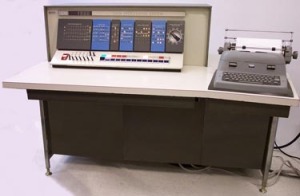
- Dr. Saul B. Sells is appointed as the Acting Director. [1]
- Dr. Selby Evans receives a fellowship to work on the IBM 1620 learning FORTAN for the 1620 by reading the manuals. [1]
1962
- The Frog Calls directory officially lists the Computer Center as a University department.
- Dr. Alex A. J. Hoffman is hired as the permanent Computer Center Director. Dr. Hoffman is listed as being in Mathematics, Physics and the Computer Center. [1][8]
- There are two rooms on the southeast corner of Dan Rogers Hall, rooms 115. The one in the actual corner houses the presses for the TCU Skiff. The other room holds the Computer Center. Dr. Alexander A. J. Hoffman had a private office. The shorthand reference for Dr. Hoffman is A2JH, like an algebraic expression.[8][2]
- Everyone else and all of the equipment is in one crowded room. In addition to the 1620, there are several large card-processing machines: sorter, collator, printer, reproducer plus key punches. There are lots of cabinets. Any flat surface is used as a table for coding and checking programs. The old 1620 is on the south wall.[8][2]
1964
- The Skiff presses are moved to allow expansion of the Computer Center to hold the newly acquired IBM 1401. The 1401 takes a lot of space compared to the 1620 because it has
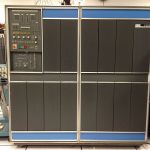
- a fast printer, 4 magnetic tape drives and two disk drives with a capacity of 2 million characters each (not a typo!). The printer provides much faster turnaround for student jobs. The expansion also allows more desk space for staff. The other room still contained everything it had in 1962.[8][2]
1966-1967
- The IBM 360/20 is purchased. It uses HASP to connect to
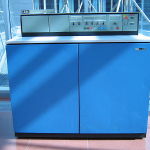 UT-Dallas to do some research jobs. Student jobs are also fed into the IBM 1401 (Old Blue} and it “spooles” the jobs to tape as it adds the necessary JCL for running. Then the tape is put on the 360 and it sends the jobs to UTD. Later later we connect again and the output printed on our printer.[2]
UT-Dallas to do some research jobs. Student jobs are also fed into the IBM 1401 (Old Blue} and it “spooles” the jobs to tape as it adds the necessary JCL for running. Then the tape is put on the 360 and it sends the jobs to UTD. Later later we connect again and the output printed on our printer.[2]
1968
- The School of Education acquires an IBM 1500 Computer Aided Instruction machine for CAI research. The 1500 is an IBM 1800 with specialized terminals and software. This is housed in the red portable building just west of the Bailey Building (later the site of Palko Hall). Dr. Herbert LaGrone is the Dean. Glenn Habern provides technical support.[8]
- There
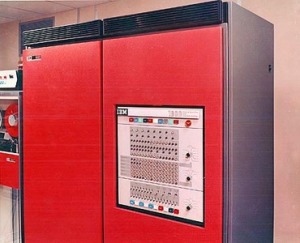 are two rooms, one for the computer and the other for classroom/lab. It had the 1800/1500 and is only used by a few people mainly in IBR and Psychology working on externally funded grants (National Institute of Health, NASA, etc.). The School of Education has some classes that use the 1800/1500 for writing “online” programs to teach students. [2]
are two rooms, one for the computer and the other for classroom/lab. It had the 1800/1500 and is only used by a few people mainly in IBR and Psychology working on externally funded grants (National Institute of Health, NASA, etc.). The School of Education has some classes that use the 1800/1500 for writing “online” programs to teach students. [2]
1969
- TCU builds a large computer room (the “Machine Room”) in the new Sid Richardson Science Building with a large glass wall and doors along the hallway so everyone can view the machines.[2]
1970
- The Computer Center moves in the summer with the IBM 1620, 1401, IBM 1800/1500 and a new IBM 360/20.
- The IBM 1800/1500, 1401, and 1620 are kept in SWR for some time. A 2nd 1620 is also given to TCU and is on the back of the Machine Room on the South Wall.[2]
- TCU’s 1620 is in the large room just South of the Machine Room – later a staff terminal room and then the SWR 160 Office Suite. This is where researchers come to do their jobs,. Some early users are Dr. Bill Koehler who does his Chemistry jobs at nights and weekends ad Dr. Leigh Secrest. It also runs simulations for the School of Business called MarkSim (Market Simulation) and RETSUM, a market Simulation written by Dr. Gibson from the TCU School of Business.[2]
- Craig Elders teaches Computer Science for a year at Trinity Valley High School and Dr. Hoffman sets it up so those students can come up to TCU, punch their cards and learn to program.
- Eventually the 360/20 is replaced with a 360/25 with disk and tape units and is used for administrative, research, and student jobs.[2]
- The School of Business also has some GE Terminals up on the 2nd or 3rd floor. You can dial up one or more computers on the grey phone next to it and when you got “that modem sound” you punched DATA and went to work very slowly – it was an old “teletype” machine and runs at 110 baud.[2].
1973-1974
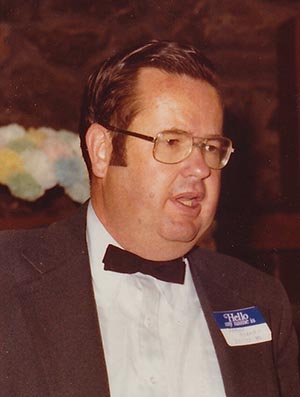
- Franklin C. Forney (Frank) is hired as Computer Center Director to replace Alex Hoffman who continued teaching Computer Science courses as the Director of the program within the Mathematics Department. The IBM machines are still in use.[4]
- TCU acquires the Xerox Sigma 9 running CP-V and replaces the IBM
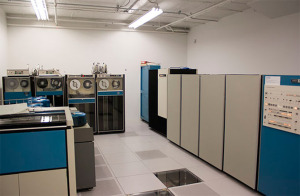 computers. The Sigma 9 is advanced for its day with 32 bit memory locations that can be addressed as individual bytes (8 bit), halfwords (16-bits), words (32-bits), or doublewords/longwords (64-bits).[3][6]
computers. The Sigma 9 is advanced for its day with 32 bit memory locations that can be addressed as individual bytes (8 bit), halfwords (16-bits), words (32-bits), or doublewords/longwords (64-bits).[3][6] - The Sigma 9 replaces all four IBM machines (1620, 1401, 1800, 360/25). It simultaneously supports batch processing, time sharing, data base processing and remote job entry from multiple sites. It allows most of the external batch and time-sharing computing to return to campus.[3][8]
1974-1979
- In the student keypunch room (in the northwest corner of what is later SWR 150/151 TCU has 6 or so old IBM 026 keypunch stations (here’s a video of the IBM 026 card punch in operation), 2 IBM 029 keypunch/duplicators and 2 Tektronix 4010 terminals (for an early Nursing simulator). The older keypunches were BCD card format although the Xerox Sigma 9 was an EBCDIC machine so you have to “double punch” to produce some characters. You punch your cards and then turn them in at the desk. The operators run the job and later (sometimes many hours later) return your cards and output to a stand where you pick them up[6]
- Across the hall from the glass doors is a terminal room for students to use with the Sigma 9’s interactive capability. There are 4 or so IBM 2741 terminals which are built on the IBM Selectric typewriter and one Datapoint 3300 terminal that was a FAST 300 baud and an incredible step up from the hardcopy terminals (look Ma, no more paper!. The 2741’s used a typeball and could be used for standard programming or APL programing which had a slightly different character set. We play a Star Trek game where after each move the terminal reprints the playing grid with your new location. A lot of paper was used for one full game.
- The Computer Center staff has a smaller separate keypunch room across from the glass doors (later the electrical room) where they have 2 keypunch/duplicators. The staff’s terminal room which is later part of the SWR 160 suite has around 5 or 6 110 and 300 baud terminal and eventually a few very prized 1200 baud terminals you had to schedule. Staff do not have a private terminal in their offices.[2][6][7]
- A remote terminal connection is set up between the Psychology Dept. and the Sigma-9.
- The original “core” memory on the Sigma-9 is upgraded to the new “MOS” memory using semiconductor-based memory. The maximum memory is 2 megabytes.[6]
1981
- The programming group moves out of the Computer Center and the Management Information Systems (MIS) department is created.[3]
- Dave Edmondson is appointed the Director of MIS.[3]
- TCU creates a Computer Science Department chaired by Dr. Kurt Schember along with faculty members Dr. James Comer and Dr. Tom Nute.[6]
1982-1984
- TCU acquires the DEC VAX 11/780 running the VMS operating System, an
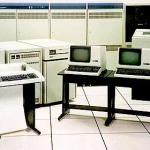 IBM 4341 and later an IBM 9370 to replace the Xerox Sigma 9.
IBM 4341 and later an IBM 9370 to replace the Xerox Sigma 9. - The VAX is initially used for Computer Science faculty and students. Later other models like the 6200, the 8600 and VAXstations are purchased for the Library’s DRA system, the Advancement’s Banner system, remote boot and file storage for computer labs and general student computing. There are 9 VAX computers at the peak of their use. The VAX systems initially used the DECnet protocol for communications and machines were named CCVAX1, CCVAX2 etc. for Computer Center VAX. Later when the department’s name is changed and the VAX architecture is replaced by the Alpha architecture the machines use the naming convention ISVMS7 etc. [6]
- The IBM 4341 run OS/VS1, CICS and VM/CMS operating Systems for
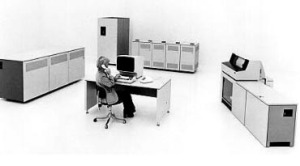 administrative users and some academic users. The 9370 runs the MUSIC Operating System (developed by McGill University) for interactive administrative and academic use.
administrative users and some academic users. The 9370 runs the MUSIC Operating System (developed by McGill University) for interactive administrative and academic use. - The 4341 was later upgraded to an IBM 4381 and OS/VS1 was replaced with MVS. Later the 4381 was updated to an IBM 4381-ESA and MVS went to MVS/ESA.[2]
- A Gandalf terminal switch is installed to allow user terminals to connect to any of the operating systems. The terminals are directly connected via individual phone wire which runs from inside Sid Richardson, Winton-Scott, Sadler Hall, Dan Rogers Hall and later elsewhere to a wall of phone punch blocks next to the south machine room door and then to the Gandalf. Doug Jones hand solders each wire to the Gandalf to make sure they don’t come lose. For the non-local connections a line driver was used to boost the power. [5][6]
- Rolaids shot a commercial using the machine room and its “cool” tape drives, consoles and lights as a backdrop. This is looking south from inside the computer room. Click on the image to get to the full video.
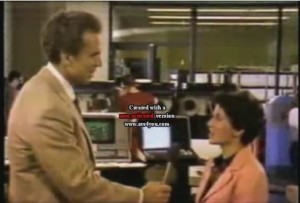
1987
- TCU creates its first ethernet network connecting Sid Richardson, Sadler Hall, Dan
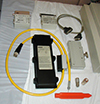 Rogers Hall and the Library. Initially the buildings are connected with “Thick Wire” 10Base5 cable and “Vampire” taps since they could run 500 meters. Within the buildings we run 10Base2 cable. [6]
Rogers Hall and the Library. Initially the buildings are connected with “Thick Wire” 10Base5 cable and “Vampire” taps since they could run 500 meters. Within the buildings we run 10Base2 cable. [6] - Dr. Art Busbey and the Geology Department installs a computer lab with 4 (or 5) Mac Pluses on AppleTalk that were connected to a Reach File Server device (eventually two of them) so that units were booting off the file servers and saving data there as well. This is the first remote boot and network file share implementation at TCU. Total space was only 40 MB or so.[9]
- The Computer Center and MIS are merge into Information Services.[6]
- Dave Edmondson becomes Assistant Vice Chancellor, Information Services.[3]
1988
- TCU connects to an outside network for the first time after connecting to UTA and the “store and forward” RSCS-based Bitnet network over a 9600 baud modem.The IBM’s have node names like TCUAMUS (MUSIC OS) and TCUACMS (CMS OS). The VMS machines have names like TCUAVMS, TCUBVMS etc.[6]
1989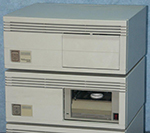
- Tandy Hall is built and hosts the first computer lab that uses a central IT server to remote boot and to store its applications and files. The server is a VAXstation 2000 with < 512MB of disk space.[6]
1990
- TCU acquires its class B TCP/IP address space (138.237.0.0/16) and its network name TCU.EDU.[6]
- The DEC VMS machines now have names like alpha.is.tcu.edu, gamma.is.tcu.edu etc. through theta.is.tcu.edu. The IBM machines are tcuamus.is.tcu.edu and tcuacms.is.tcu.edu.[6]
1993
- Dr. Leigh Secrest, Vice Chancellor of Business and Finance retires and Information Services moves from under his area to under the Vice Chancellor and Provost, Dr. William Koehler. Dave Edmondson becomes Assistant Provost, Information Services.[3]
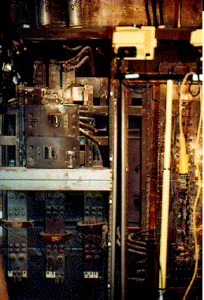 While installing a new battery backup system to replace the motor generator, one of the main power circuit breakers in the boiler room blew up catching the panel on fire. The fire burned the sheathing of the wire up thru the conduits. By Sunday an emergency generator is parked in the loading dock between SWR and Winton-Scott with wires running down the stairs into the boiler room. The mainframes are back online by Sunday afternoon and the generator feeds limited power to the building for the next week while electricians replace the old wiring (ALL) with new copper wire.[7]
While installing a new battery backup system to replace the motor generator, one of the main power circuit breakers in the boiler room blew up catching the panel on fire. The fire burned the sheathing of the wire up thru the conduits. By Sunday an emergency generator is parked in the loading dock between SWR and Winton-Scott with wires running down the stairs into the boiler room. The mainframes are back online by Sunday afternoon and the generator feeds limited power to the building for the next week while electricians replace the old wiring (ALL) with new copper wire.[7]
1995
- The dorms are networked and a set of 3 FDDI rings are created on the west side of campus, two for dorms (Worth Hills and Main Campus) and one for academic and administrative buildings. A Cisco router is installed in the Pete Wright building to route between the rings and the east side of campus.[5]
2003
- The IBM mainframes 4381 was shutdown.[3]
2006
- Information Services becomes Technology Resources/[6]
2007
- Bryan Lucas becomes Executive Director, Technology Resources.[6]
2012
- Technology Resources becomes Information Technology. Bryan Lucas becomes Chief Technology Officer.[5]
Employees:
In addition to the employees mentioned above here are some of the people that worked in the Computer Center over its first 25 years. This is in rough chronological order of the hire date.
Alex A. J. Hoffman
Bill Haughey
Frank Forney
Craig Elders
Sara Looper
Wanda Sherman
Robin Mayne
Richard Yantis
Jon Eidson
Dave Edmondson
Ivan Taylor
Jim Mayne
Eric Klein
Bill Senter
Karen Bowerman
Stephanie Polly
Terrie Harbour
Rebecca Glass
Josh Harmon
Stories:
Here are some of the personal stories related over the years
Craig Elders
- About Zelda (the Sigma 9) – I don’t remember a memory upgrade on that. HOWEVER, after we got the IBM 4381/ESA we did replace our old IBM (core) memory and expand it with EMC memory. I think it was a MEG we acquired, but don’t remember. We also collected a lot of LARGE IBM Discs (3380s I think was the number). They were cheap on the used market and we were needing more and more disk space. We eventually replaced all the 3380 disk drives with a huge disk array – Can’t remember who made the disks – Jon E worked with them the most and will remember). By the way, we tried to upgrade to faster and newer drives justifying the cost of the new disk system with the cost of electricity. All those old HUGE IBM disks used LOTS of electricity and the new modern Disk Arrays used significantly less electricity. I wrote a big report on the cost savings to the University as well as increasing our storage and decreasing response time. The new disks would pay for themselves in just a couple of years, I think. However, my answer as to why we could not get them was that the money saved on electricity was not in our department’s budget – but rather part of the Physical Plant. So even though it saved TCU money, it didn’t change our budget and thus no new disks. (Again, don’t know if this is any use but when I think back that far, I get a brain dump!)
- By the way, after we converted from the Sigma 9 to the IBM 4341, our little system was very slow and we had problems getting all the jobs run and response time during the day with batch as well as online. I used that huge IBM graph printer to illustrate the problems with response time, disk space, disk access time, etc. Dr. Secrest got back to me and said that he knew we need more hardware and if Oil Price ever got to $20 a barrel, I could get more disk. It took a while, but we eventually got some more disks once our Oil Resources were bringing in $20.
Bill Haughey (worked at TCU from 1962 – 1977)
- An undergraduate student employee for 4 years (1962-1966 – fall & spring). He also worked the summer of 1963. During 1966-1968 he was a graduate student working half time as part of his fellowship.
- He served as Assistant Director from July 1972 until November 1977.
- Here are some of the people I remember in the fall of 1962-1968:
- In the fall of 1962, in addition to Dr. Hoffman, there were five other employees. Gordon Dobbins was a graduate fellow working on a masters degree in Mathematics. Part-time undergraduate student employees included Mary Tyson, John Gilliland and Bill Haughey. There was an administrative assistant also, but I don’t recall the name.
- Undergraduate student employees: John McLean, Karyl Palmer, John Reynolds, Mason Dixon, Phil Jones.
- Student employees who supported School of Business: Jackie Carroll, Helen Howard, Donnie McReynolds.
- Graduate students who had CC fellowships: John Roach (MBA), Dr. Woody Sconyers (PhD in Mathematics), Dr. Tony Bielecki (PhD in Physics).
- Full time staff: David Smith was a full time applications programmer for administrative work such as the payroll system: David LaGrone; University administrative support for university: Ruby DeMent.
- Some of the people who worked at the TCUCC 1972-1977:
- Undergraduate students: Craig Elders, Mike Bourne, Sharon McAdoo, Steve Myers,Jon Eidson, Richard Yantis
- Graduate students who had CC fellowships: Phil Jones, Bill Widmer, Linda (May) Jones, Denny Irons, Mike Bowen
- Full time staff: David Geeseka, Mike Abbamonte, Dr. Ivan Taylor, Dr. Norm Stemple,Muriel Pargaman, Kathy Bice, Thom Henry, Ann Wakeman,Howard (Robbie) Robinson, Ken Schulte
Eric Klein
- My best memory is of the Rolaids commercial and that Roger Staubach had to ask me how to use the phone because he had never seen a phone with buttons for multiple lines before. And of course I will have to include a mention of Ken Schulte’s “bug fixes” by squishing cockroaches with his stick, and of course Ralph’s “gjob qfumble.l” commands at the console. Such good times!
Jim Mayne (worked at TCU from 1980 to 2017)
A bit of Networking history at TCU
Within TCU, machines were initially connected based on proprietary vendor protocols like DECnet for the DEC VAX’s and RSCS for the IBM systems. The VAX hostnames were CCVAX1, CCVAX2, CCVAX3 which stood for Computer Center VAX 1 etc. Later when the department changed its name to Information Services the DECnet hostnames changed to ISVMS1, ISVMS2 etc. The “VAX” part of the name also changed to “VMS” as DEC moved the VMS and OpenVMS operating systems from the VAX processor architecture to the alpha and intel architectures.
The first network connecting TCU to any outside users was Bitnet. This stood for “Because It’s There Network”, but it eventually came to mean “Because It’s Time Network”. This network used the IBM RSCS protocol which is a store and forward protocol. A request went from TCU to UTA, our next upstream neighbor and then when they were ready they transferred it to their upstream neighbor and so on. For TCU and most others in the eastern half of the country the data went eventually to Princeton if the destination was not on the way. From there it then went down to the destination, one hop at a time. Because of this Bitnet was used for tasks like email, file transfers and gopher.
TCU’s connection to UTA was initially over a 9600 baud modem under the machine room floor in Sid Richardson. The TCU side of the connection was to a DEC VAX. The Bitnet hostname was TCUAVMS. The IBM machines then connected to TCUAVMS and included the IBM 4341’s TCUAVM and the 9370’s TCUAMUS (running the MUSIC operating system). Eventually there were others like TCUBVM and TCUBVMS.
DEC thought that they had scooped everyone in the 80’s by creating a new version of DECnet called DECnet/OSI which was a seven-layer OSI-compliant networking protocol. At the time it looked like the government would require OSI-based protocols in their projects and so DECnet/OSI would be THE network standard. Unfortunately Unix was gaining ground at the same time and with it TCP/IP. Soon the number of machines running TCP/IP was too great and DEC as well as Microsoft, Apple and IBM had to accept the inevitable and incorporate TCP/IP into their protocol.
I applied for the TYCP/IP address space in 1989. There was no charge and anyone that asked received a class C address space with 256 addresses but of course we all wanted the class B spaces that would give us 65,536 addresses. We didn’t know what we would use them for (this was before the World Wide Web and browsers) but we wanted them. On the address space application we had to justify the larger address space request. We didn’t have more than 256 hosts machines at that time so I couldn’t use that so I justified it by the fact that we had several AppleTalk networks and they would have to be routed in a TCP/IP network so I would need several different subnets which cut down the addresses that were allowed in each to a low number and therefore we needed a class B and not a class C address space. The IANA agreed and so from then on we had our class B addresses 138.237.0.0/16.
When we started networking VMS machines with TCP/IP I wanted more unique names so I started using the Greek alphabet
Here are the various VMS machines along with their different protocol hostnames
DECnet Bitnet TCP/IP
CCVAX1/ISVMS1 TCUAVMS alpha.is.tcu.edu
CCVAX2/ISVMS2 TCUBVMS beta.is.tcu.edu
CCVAX3/ISVMS3 TCUCVMS gamma.is.tcu.edu
ISVMS4 delta.is.tcu.edu
ISVMS5 epislon.is.tcu.edu
ISVMS6 theta.is.tcu.edu
ISVMS7 eta.is.tcu.edu
ISVMS8 zeta.is.tcu.edu
ISVMS9 iota.is.tcu.edu
Sources:
- [1] Dr. Selby Evans
- [2] Craig Elders
- [3] Richard Yantis
- [4] Marilyn Hallam
- [5] William Senter
- [6] Jim Mayne
- [7] Jon Eidson
- [8] Bill Haughey
- [9] Art Busbey